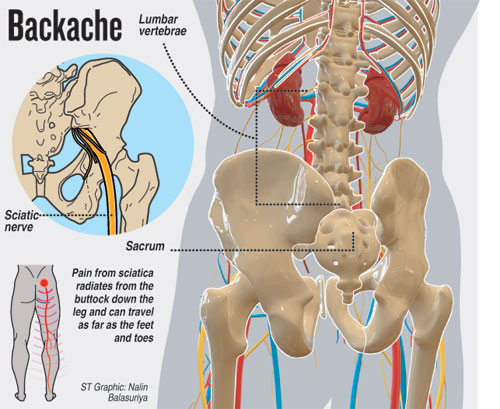Stand right, sit right
View(s):Senior Consultant Neurologist Dr. J. B. Peiris answers some common queries about backache
From where does backache arise?
Backache arises from structures in the midline in the back – namely the bones in the spine (vertebrae), discs, spinal muscles, and nerves – arising from the spine supplying the legs. Organs in the abdomen (liver, kidneys, intestines, and pancreas) cause abdominal pain – front of abdomen. Diseases of kidneys may cause pain on either side of the spine (loins).
 How common is backache?
How common is backache?
About 40% of people have low back pain (LBP), at some point in their lives.
Pain may be acute (lasting less than 6 weeks), sub-acute (6 to 12 weeks), or chronic (more than 12 weeks). Pain radiating down the leg, in line with the sciatic nerve, is called sciatica. The majority of LBP does not have a clear cause but is believed to be the result of non-serious muscle or skeletal issues such as sprains or strains.Women may have acute low back pain from medical conditions affecting the female reproductive system,
Structures in the back
The lumbar (or lower back) region is made up of five lumbar vertebrae (L1-L5), and sometimes includes the sacrum. In between these vertebrae are fibrocartilaginous discs, which act as cushions allowing flexibility and preventing the vertebrae from rubbing together, while at the same time protecting the spinal cord. Nerves come from and go to the spinal cord through specific openings between the vertebrae, providing the skin with sensations and messages to muscles.
What are the common causes?
- Muscle strain of the large, long paired muscles at back called erector spinae
- pain arising from the bones, ligaments or joints
- A degenerating intervertebral disc.
- Irritation of the large nerve roots in the low back that go to the legs.
Many lower back problems while causing pain of varying degree, may also cause muscle spasm and curvature of the spine (scoliosis)
What is sciatica?
Sciatica is pain along the sciatic nerve – the longest nerve in the body. It is often caused by a prolapse of a disc in the lumbar spine (Usually L4 and L5 vertebrae or L5 and S1 vertebrae). It may be accompanied by curvature of the spine (scoliosis), weakness and or numbness of the foot.
Do all patients with backache or sciatica need a MRI scan of the spine?
No.
Only those who have detectable weakness or sensory loss and those who do not respond to medical treatment
Do all patients with sciatica need surgery? If not who needs surgery?
Only a few patients with sciatica need surgery. These include
- Severe pain not responding to medical treatment, including an injection to the spine (epidural injection)
- Those who develop weakness of the foot
- Those who have detectable loss of sensation in foot or leg
Is surgery indicated in all patients showing a disc displacement in the MRI scan?
Do not forget that the lumbar spine and neck are moving thousands of times for a day and a MRI will show ‘wear and tear’ changes in most patients over the age of 50-60 years. Unfortunately the MRI scan shows age related changes which need correlation with symptoms. Surgery is indicated if the MRI changes correlate with the indications for surgery listed above.
What is the medical treatment of backache and sciatica?
Adopting the correct posture while standing and sitting, and sleeping on a firm surface that does not sag, is important – the spine should be straight. A comfortable lumbosacral support in the form of a belt helps in maintaining this posture especially while working and travelling. The treatment of acute nonspecific low back pain of rapid onset is typically with simple pain medications and the continuation of as much normal activity as the pain allows.
Avoid bending the spine and carrying anything heavy. Medications are recommended for the duration that they are helpful, with paracetamol as the preferred first medication.Stronger pain killers, steroids which reduce swelling of nerve sheaths and lumbar traction may be considered after a few weeks of simple treatment.


